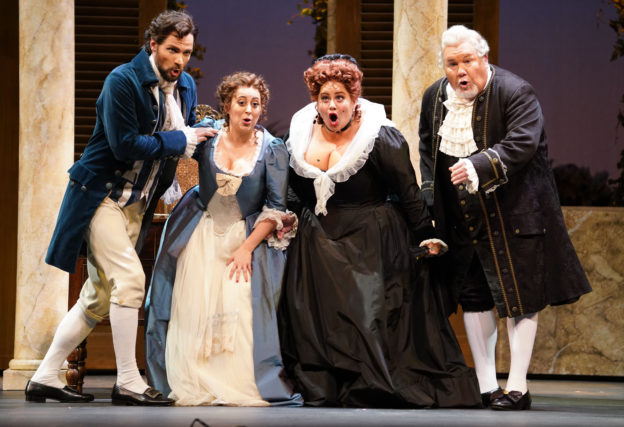
Review: Class strife classic holds up under modern pacing in ‘The Marriage of Figaro’
By Review by Ruth O. Bingham, Special to the Star-Advertiser
Valentine’s Day ruled on both sides of the proscenium at Hawaii Opera Theatre’s buoyant production of Mozart’s comic love story, “The Marriage of Figaro.” Red carnations popped up in almost every scene and the audience came dressed in every conceivable shade of red.
Love — crazy, maddening, amusing, touching — served as theme and plot, the latter too convoluted for summary here. “Figaro” does not seem remotely subversive today, but when it was composed in the 1780s, it was part of the American and French revolutions and dangerous stuff, banned by censors.
Its central conflict was class rivalry between the servants (Figaro and Susanna) and nobles (the Count and Countess). In a time when nobles always won, Figaro and Susanna got their way.
The world was changing.
The overture, taken at breakneck tempo by conductor David Angus, signaled HOT’s focus on madcap comedy, with charming period costumes, bright-hearted lighting, vivacious staging, and airy set designs. HOT’s English supertitles, updated into modern lingo that at times belied the period setting, added touches of farce.
At its core, “Figaro” is a study in musical characterization — bustling machinations by servants, blustering patter by petty bourgeois, the breathlessness of hormone-driven adolescents — and the roles come alive in different ways with each new cast.
As Figaro, baritone Ryan Kuster, tall, handsome, with good stage presence, created an appealing leading man. His voice, of moderate size, was frequently covered in ensembles and full orchestra, but he shone in his reflective aria in the final act, sitting on the edge of the stage before a closed curtain.
In the balance between Figaro and his bride, Susanna ruled. Elena Galvan’s clarion soprano and vivacious acting placed Susanna at the center of the maelstrom, driving the action. Galvan was especially impressive for stepping in at the last minute with an outstanding performance.
Mane Galoyan was an absolute delight and delivered an outstanding Countess Almaviva. Her climactic Act III aria (“Dove sono/Where are the moments”) was especially moving, sung with flawless silky lyricism, timbral color and depth.
Her partner, Count Almaviva, has become a more challenging role over the decades as society’s perspective on sexual propriety has shifted, but baritone Edward Parks was able to make the Count more misbehaving than evil. He has a lovely voice, excellent technique and proved noble of tone, well worth hearing.
Mezzo-soprano Olivia Vote, in the “double trouser” role of Cherubino (a woman playing a young man dressed up as a woman), beautifully portrayed the gangliness of adolescence, and her lush voice conveyed the warmth of being in love with love.
“Figaro” has an astonishing 11 named roles, each one a gem. HOT’s cast made the most of their moments, adding so many comic details, it was challenging to catch them all: Kevin Glavin and Jenni Bank as the bustlingly bourgeois Doctor Bartolo and Marcellina; scene-stealing Jamie Offenbach as Antonio; vivacious Martina Bingham (no relation) as Barbarina; outrageous Joseph Gaines as both Don Basilio and Don Curzio; and the delightful HOT Opera chorus as everyone else.
Also of note were locals Stephanie Holladay and Sarah Lambert Donnelly from HOT’s Studio as the Due Donne (two ladies).
HOT’s gracious set, designed by Steven C. Kemp for Opera San Jose, made it possible to present Mozart’s four acts with only one intermission: Act I was a clever room-within-a-room that transformed quickly into a single room for Act II, and Act III was anchored by columns in the count’s study that morphed smoothly into a garden pergola.
Perhaps the most profound difference between 18th- and 21st-century expectations lies in dramatic pacing. Audiences today expect the pace to increase to a climax, but in works such as “Figaro,” as indeed in much of opera, just as tension rises — surprise! — action pauses while one of the characters sings.
That can feel as though the dramatic tension is interrupted, but not so: Those pauses are intended to give the audience time to reflect on the situation and the character’s emotional state, and thus enjoy it more fully. In opera, the goal is not a headlong dash to climax but to relish that moment of tension to its fullest … and hence, the aria. Sit back, explore how the moment feels, and enjoy.
Both director Tara Faircloth and conductor Angus kept the pacing brisk and delivered a lively, thoroughly entertaining “Figaro.”
Emmanuel Plasson will conduct on Tuesday.
—
>> Running time: 3 hours. Suitable for all audiences, although youngsters will need a detailed explanation of the plot in advance.
Ruth O. Bingham received her doctorate in musicology from Cornell University and has been reviewing the musical arts for more than 25 years.
